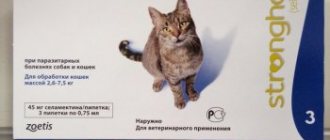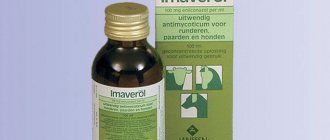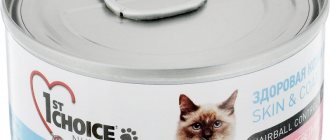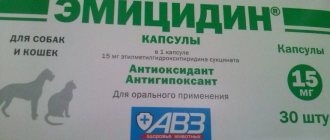general description
The antibacterial agent is produced in the form of an injection solution. The antibiotic is produced by different pharmacological companies, so you can find different packaging in pharmacies. Externally, the solution is transparent, although it has a light yellow tint. It is characterized by a slightly viscous consistency.
For packaging, bottles made of clear or dark glass are used. To maintain tightness, they are sealed with rubber stoppers, which are rolled up with aluminum caps. Bottles come in different sizes: 20, 50 and 100 ml. In most cases, it is wise to buy small bottles for cats.
The active component of the drug is the substance of the same name – tylosin. The antibiotic is available in pharmacies in two versions - Tylosin 50 and Tylosin 200. The only difference is the content of the active substance - 50 and 200 mg per 1 ml of solution, respectively. In both cases, the composition also includes auxiliary components:
- gasoline alcohol;
- purified water;
- propanediol
Note! For cats, it is recommended to use a drug with index “50”. The concentration of the active substance in it is less, and therefore it is easier to calculate the correct dose for a small animal, thereby preventing an overdose.
There is no need to observe special conditions when storing the drug. The air temperature should be between 10 and 25˚C. After opening the bottle, the injection solution can only be used for 28 days, after which it must be disposed of.
Pharmacological properties
Tylosin has pronounced antibacterial properties. The drug, developed specifically for animals, is effective against the following types of pathogenic microorganisms:
- hemophilus influenzae infections;
- streptococci;
- staphylococcus;
- mycoplasma;
- Leptospira;
- chlamydia;
- pasteurella;
- corynobacteria, etc.
The principle of action of the active substance is to block bacterial protein synthesis. The antibiotic is quickly absorbed and just an hour after injection its concentration in tissues reaches its maximum value. The effect of the medicine lasts for 20-24 hours. Tylosin is excreted from the body primarily through bile and urine. In lactating animals, the active substance can penetrate into the milk.
Based on the degree of impact, the drug is classified as a low-hazard substance. If the recommended doses and dosage regimen are followed, it is well tolerated by animals and does not cause local irritant reactions or addiction.
Table: overview of the main characteristics of the drug Tylosin and its analogues
| A drug | Compound | Release form | Indications | Contraindications | Price, rub |
; Russia | Tylosin | Solution for intramuscular injection in bottles of 20, 50, 100 ml, 50 and 200 mg of tylosin per ml |
| Individual intolerance to Tylosin components | 115 rubles for 50 ml Tylosin 50 |
| Tylanik. ; Russia | Tylosin | Solution for intramuscular injection in bottles of 10, 50, 100, 200 ml, 50 or 200 mg of tylosin per ml |
| Individual intolerance to Tilanik components | 345 rubles for 100 ml of 20% tylosin solution |
| Farmazin 50, 200, 500, 1000. Manufacturer Huvepharma; Bulgaria | Tylosin tartrate | Solution for intramuscular injection containing 50, 200, 500, 1000 mg of tylosin in 1 ml in bottles of 25, 50, 100 ml |
| Individual intolerance to Farmazin components | 115 rubles for 50 ml Farmazin 50 |
| Tylosinavet 200. ; Belarus | Tylosin | Solution for intramuscular injection containing 200 mg of tylosin per 1 ml in bottles of 50, 100, 200, 400, 450, 500 ml | For the treatment of diseases:
|
| 365 rubles per 100 ml |
When comparing Tylosin preparations, it is worth noting their absolute interchangeability and affordability. The Belarusian drug Tylosinavet has the most detailed instructions, which is very impressive for its manufacturer. Farmazin, Tylosin and Tilanik have dosages that are convenient for use in cats.
Price
When purchasing Tylosin 50 for cats, please note that the price depends on the volume of the package:
- 20 ml – 48-60 rub.;
- 50 ml – 115-130 rub.;
- 100 ml – 140-180 rub.
The cost of Tylosin 200 is slightly higher. For a bottle with a capacity of 20 ml you will have to pay about 85-90 rubles, and a package of 50 ml - 150-160 rubles. You can buy the medicine at any veterinary pharmacy or clinic. The antibiotic is also available in many online pharmacies for animals.
You can now view the current price of the drug and buy it right here:
Duration and storage conditions of the medicine
The shelf life of Tylosin is 14 months from the date of production, which must be indicated on the packaging. In a closed container, the medicine should be kept at a temperature of 10° to 25°C. Once a bottle of antibiotic is opened, it should be used within a month. Store opened packaging in the refrigerator. If the opened bottle is kept at room temperature, the medicine will deteriorate, which will be indicated by clouding of the solution and the formation of a brown precipitate - such a medicine should be disposed of, it is unsuitable for treatment.
Indications for use
According to the instructions for use, Tylosin is prescribed to cats for the treatment of the following pathologies:
- pneumonia;
- tracheitis;
- bronchitis;
- other diseases of the respiratory system;
- arthrosis and arthritis;
- inflammatory processes of the genitourinary system, in particular mastitis;
- mycoplasmosis;
- chlamydia;
- dysentery, etc.
The drug is also used for secondary infections that accompany viral diseases. Sometimes an antibiotic is prescribed for purulent wounds and inflammatory processes caused by harmful microorganisms.
Dosing of the drug
- The dose of tylosin is 200 in dogs - 0.025-0.05 ml/kg body weight.
- The dose of tylosin-50 for dogs is 0.1-0.2 ml/kg body weight.
Tylosin-50 is a special antibacterial substance that is primarily used to fight bacterial infection in dogs and other animal species. This substance is synthesized by microbes - Actinomycetes and Streptomyces fradiae; it is a macrolide antibiotic used to treat diseases in dogs that cannot be treated with other methods.
It is important to note that Tylosin is not FDA approved for use in pets, but it is a prescription drug that can be purchased legally from veterinarians and is best used as directed by a veterinarian.
We invite you to familiarize yourself with simple and tasty recipes for pickling cabbage in brine with salt and sugar
Instructions for use
Animals are given injections of antibacterial agents only intramuscularly. Subcutaneous administration of the drug can cause inflammation and necrosis at the injection site. According to the instructions for use, the dosage of Tylosin 50 for cats is calculated taking into account weight - 0.1-0.2 ml per 1 kg of weight. The exact dose must be determined by the doctor, taking into account the degree of development of the disease, existing symptoms, possible complications and other factors. Tylosin 200 for cats is rarely used due to the high concentration of the active substance, but if for some reason it is used, the dosage is calculated as follows - 0.025-0.05 ml per 1 kg of weight.
Injections of the drug should be done once a day. The duration of treatment is from 3 to 7 days, depending on the symptoms and severity of the disease. It is not recommended to skip injections, as this leads to a decrease in the effectiveness of the antibacterial agent.
Note! You need to inject the medicine for the entire course prescribed by the doctor. You should not stop treatment if the animal’s condition improves. In this case, the risk of re-development of the pathology or the appearance of complications increases.
Reviews about the drug, what cat owners say
Cat owners say Tylosin is inexpensive and effective.
Anna. There was a problem with the cat. They took the animal to the dacha, where it roamed freely. When we returned home, he began to have severe diarrhea, which did not go away for three days. We went to the veterinarian, they recommended Tylosin 50. We injected him into the hind leg for 5 days, and the stool returned to normal on the second day. A very good drug, and most importantly, effective.
Valeria. Our cat got sick, and suddenly. The main symptoms were fever, cough, lethargy, and discharge from the eyes. At first they thought that the cat had a cold and tried to treat it themselves. After 2 days, the animal’s condition worsened and I had to go to the veterinarian. As a result, we were diagnosed with pneumonia and were told that we were on time. The antibiotic Tylosin 200 for cats was prescribed. The course lasted a week, injections were given once a day. The first improvements became visible on the 3rd day, and by the end of treatment the cat was already playing and actively eating.
Igor. My daughter picked up a kitten on the street. He had a lot of problems and, in addition, he also had a respiratory infection. They immediately took him to the veterinarian, where, in addition to all sorts of vitamins and anthelmintics, they prescribed Tylosin. I read about this antibiotic on the Internet and bought it. At first I doubted that there might be complications, but the kitten tolerated the treatment well. They injected him for about 5-7 days. As a result, today we have a very cute, active and cheerful animal.
Tylosin is a drug with a very broad spectrum of action. Despite the fact that the medicine is very easily tolerated by cats of all ages, it will still be better if you can consult with a veterinarian before using it, who will help you choose the right dosage.
Contraindications and side effects
The antibiotic is prohibited for animals that have an individual intolerance to the components, in particular tylosin. In this case, it is worth choosing another antibacterial agent for treatment.
The drug should be taken with caution for lactating animals. The active substance can penetrate into milk, and with it into the body of kittens. Sometimes this leads to severe dysbiosis, which can manifest itself as loose stools and other unpleasant symptoms. In each case, the risk for kittens and mother is assessed individually. The medicine should only be used in nursing cats under the supervision of a physician.
Note! Tylosin should absolutely not be combined with penicillin antibiotics and other antibacterial agents. In this case, the risk of allergic reactions increases.
If intolerance occurs, respiratory diseases, itching, redness and other allergic reactions may occur. To prevent them, the antibiotic is combined with anti-allergenic drugs (Tavegil, Suprastin, Diazolin, etc.). In rare cases, loose stools or other gastrointestinal disturbances may occur. In most cases, the drug is well tolerated by cats and does not cause side effects.
Advantages and disadvantages
Tylosin is considered one of the safest antibiotics for animals, and cats in particular. It was designed with pets in mind. Its main advantages include the following:
- High efficiency.
The animal feels better after 1-2 injections. - Wide spectrum of action.
The drug can be used for diseases of the respiratory, genitourinary and other systems, the musculoskeletal system, and suppuration of soft tissues. The active substance acts on various harmful bacteria. - Packaging volumes.
It is easy to select a bottle, taking into account the duration of treatment, the weight of the animal and other factors. - Minimum contraindications.
The drug is approved for use in cats of different ages and breeds. - Safety.
If the recommended doses are followed, side effects rarely occur.
The disadvantages include the need to do intramuscular injections. If you have no experience, you will have to take your pet to the clinic every day, and this can cause stress. Tylosin has no other significant disadvantages, but you should not use it without a doctor’s prescription.
Pros and cons of the drug
Tylosin is the safest antibacterial drug for cats.
Its main advantages:
- -Efficiency. The cat feels better after 2-3 injections.
- — Wide application . Tylosin is used in the treatment of the respiratory system, genitourinary system, and tissue decay. The drug has an effect on a large list of bacteria.
- — Release form . It is convenient to choose the appropriate bottle to treat your pet.
- - No side effects . The product is easily tolerated by animals.
- -Safety. With the correct dosage, the drug is completely safe for cats.
The only downside is the need for injections. Cats, like all animals, do not like this procedure. And you will have to take your fluffy to the doctor every day during treatment.
Owner reviews
Lyuba, owner of a British cat:
“We were prescribed Tylosin to treat pneumonia in a cat. We went to the clinic for injections every day (5 times), since I do not know how to give intramuscular injections. Additionally, the cat was given Suprastin to prevent allergies. The results of the treatment were visible within two days. We noticed no side effects."
Victoria, owner of 2 cats:
“For us, Tylosin caused severe chronic diarrhea in two cats. The drug was used to treat chlamydia. Chlamydia was cured, but for a long time they could not get rid of diarrhea. I had to completely change the diet and take feed additives with lactobacilli for a long time. The veterinarian suggested that the cause of loose stool was dysbacteriosis. This was not observed with Baytril.”










